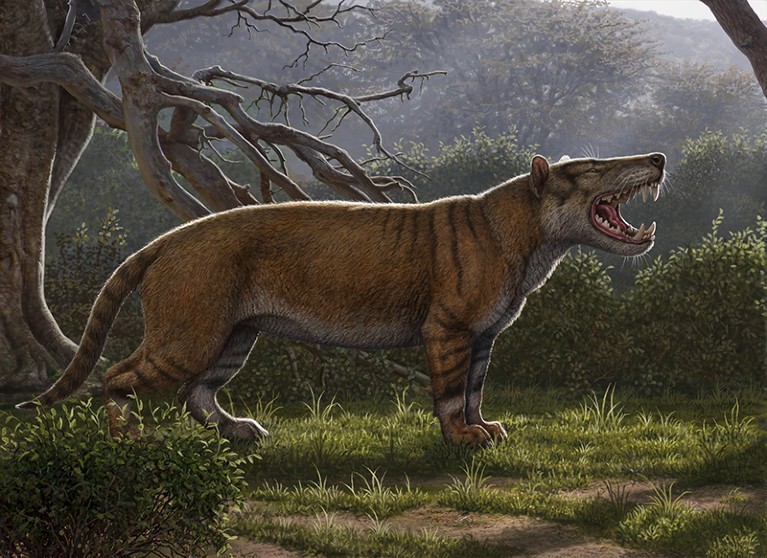Hello Nature readers, would you like to get this Briefing in your inbox free every day? Sign up here.

Simbakubwa kutokaafrika had three rows of meat-shearing teeth and was larger than a polar bear.Credit: Mauricio Anton
Ancient mega-carnivore found in a drawer
A huge jawbone that had been languishing in a museum drawer for decades belonged to a newly identified species. Simbakubwa kutokaafrika was a prehistoric predator probably bigger than a polar bear, with three rows of meat-shearing teeth. It belonged to one of the most successful carnivore dynasties of all time — the hyaenodonts — and might have looked “a bit like the wargs from Lord of the Rings”, says palaeontologist Matt Borths.
Reference: Journal of Vertebrate Paleontology paper
What it will take to maintain a liveable planet
A new report fleshes out a ‘global deal for nature’ that outlines what governments must do to have a hope of saving ecosystems and limiting global warming. Leaders around the world must fully protect 30% of Earth’s surface and sustainably manage another 20% by 2030. “What this paper is doing is putting a hard lens on what really needs to be protected,” says ecologist Jane Smart.
Reference: ScienceAdvances paper
Revived pig brains: your questions answered
Last week, we heard that scientists revived the disembodied brains of pigs four hours after death. What does this potentially mean for human brain transplantation? Could a disembodied brain be conscious? Nature’s news team answers some of your questions about the research and where it might lead.
Read more: Pig brains kept alive outside body for hours after death
Algorithms spot 1.81 million tiny California quakes
Researchers have used machine learning and supercomputers to detect millions of imperceptible earthquakes — as small as magnitude 0.3 — hiding in the seismological records of southern California. The detailed data will help seismologists to understand what’s really going on down below.
Most female physics undergraduates face harassment
Nearly three-quarters of female physics undergraduates in the US report having experienced sexual harassment while working or studying in the field. A survey of students attending a series of US conferences for undergraduate women in physics found that, of the 455 women who responded, 338 reported experiencing some form of sexual harassment — from inappropriate jokes to unwanted sexual attention. “A lot of times people study how women can change to better fit in a field or be more successful,” says physicist Lauren Aycock, the study’s lead author and a science and technology policy fellow at the Department of Energy in Washington DC. “Perhaps physics needs to think about changing itself.”
Reference: Physical Review Physics Education Research paper
FEATURES & OPINION
How US–China tensions are affecting science
Science is increasingly feeling the chill from frosty relations between the United States and China. Even world-leading quantum physicist Jian-Wei Pan couldn’t get a US visa to travel from China to collect a prestigious prize at the American Association for the Advancement of Science meeting earlier this year. Nature explores how conference travel, research visas, science funding and security clearance are all being affected by the ongoing political tensions.
Networking for introverted scientists
A structured, scientific approach can help introverted scientists to become networking superstars, says academic educator Ruth Gotian. She outlines how to prepare effectively, the three things you should aim to achieve at a networking event and how to find networking spaces that work best for you.
